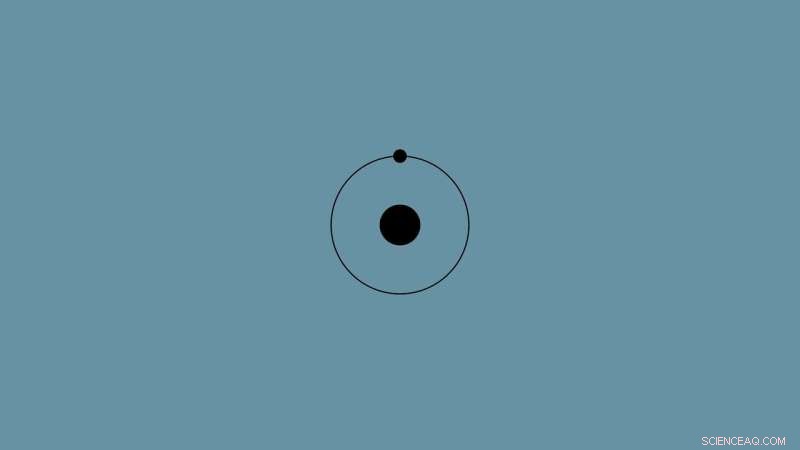
Wetenschap
Auto's op waterstof:een realistische weg naar schone energie?

Tegoed:CC0 Publiek Domein
Elke ochtend stoppen er bij een transitfaciliteit in Canton, Ohio, meer dan een dozijn bussen naar een tankstation voordat ze uitwaaieren naar hun routes in deze stad ten zuiden van Cleveland.
De bussen - gemaakt door El Dorado National en eigendom van de Stark Area Regional Transit Authority - zien eruit als alle andere. Maar samen weerspiegelen ze de voorhoede van een technologie die een sleutelrol zou kunnen spelen bij het produceren van schoner interstedelijk vervoer. In plaats van vervuilende dieselbrandstof rijdt een kwart van de bussen van het bureau op waterstof. Ze stoten niets anders uit dan onschadelijke waterdamp.
Waterstof, het meest voorkomende element in het universum, wordt, samen met elektrische voertuigen, steeds meer gezien als een manier om de milieuvernietigende impact van de 1,2 miljard voertuigen op aarde te vertragen, waarvan de meeste benzine en diesel gebruiken. Fabrikanten van grote vrachtwagens en bedrijfsvoertuigen beginnen waterstofbrandstofceltechnologieën te omarmen als een manier om vooruit te komen. Dat geldt ook voor makers van vliegtuigen, treinen en passagiersvoertuigen.
Transport is de grootste bijdrage van de VS aan klimaatverandering. Daarom wordt waterstof op de lange termijn gezien als een potentieel belangrijke manier om de CO2-uitstoot te helpen verminderen.
Zeker, waterstof blijft verre van een magische oplossing. Voorlopig wordt de waterstof die jaarlijks wereldwijd wordt geproduceerd, voornamelijk voor raffinaderijen en de productie van kunstmest, gemaakt met aardgas of steenkool. Dat proces vervuilt de lucht en verwarmt de planeet in plaats van haar te redden. Uit een nieuwe studie van onderzoekers van de universiteiten van Cornell en Stanford is inderdaad gebleken dat de meeste waterstofproductie koolstofdioxide uitstoot, wat betekent dat transport op waterstof nog niet als schone energie kan worden beschouwd.
Maar voorstanders van door waterstof aangedreven transport zeggen dat waterstofproductie op de lange termijn voorbestemd is om milieuvriendelijker te worden. Ze voorzien een groeiend gebruik van elektriciteit uit wind- en zonne-energie, die waterstof en zuurstof in water kan scheiden. Aangezien dergelijke hernieuwbare vormen van energie breder worden gebruikt, moet waterstofproductie een schoner en goedkoper proces worden.
Binnen drie jaar zijn General Motors, Navistar en het transportbedrijf J.B. Hunt van plan om tankstations te bouwen en waterstoftrucks te laten rijden op verschillende Amerikaanse snelwegen. Toyota, Kenworth en de haven van Los Angeles zijn begonnen met het testen van waterstoftrucks om goederen van schepen naar magazijnen te vervoeren.
Volvo Trucks, Daimler Trucks AG en andere fabrikanten hebben ook partnerschappen aangekondigd. The companies hope to commercialize their research, offering zero-emissions trucks that save money and meet stricter pollution regulations.
In Germany, a hydrogen-powered train began operating in 2018, and more are coming. French-based Airbus, the world's largest manufacturer of airliners, is considering hydrogen as well.
"This is about the closest I've seen us get so far to that real turning point," said Shawn Litster, a professor of mechanical engineering at Carnegie Mellon University who has studied hydrogen fuel cells for nearly two decades.
Hydrogen has long been a feedstock for the production of fertilizer, steel, petroleum, concrete and chemicals. It's also been running vehicles for years:Around 35,000 forklifts in the United States, about 4% of the nation's total, are powered by hydrogen. Its eventual use on roadways, to haul heavy loads of cargo, could begin to replace diesel-burning polluters.
No one knows when, or even whether, hydrogen will be adopted for widespread use. Craig Scott, Toyota's head of advanced technology in North America, says the company is perhaps two years from having a hydrogen truck ready for sale. Building more fueling stations will be crucial to widespread adoption.
Kirt Conrad, CEO of Canton's transit authority since 2009, says other transit systems have shown so much interest in the technology that SARTA takes its buses around the country for demonstrations. Canton's system, which bought its first three hydrogen buses in 2016, has since added 11. It's also built a fueling station. Two California transit systems, in Oakland and Riverside County, have hydrogen buses in their fleets.
"We've demonstrated that our buses are reliable and cost-efficient, and as a result, we're breaking down barriers that have slowed wider adoption of the technology," Conrad said.
The test at the Port of Los Angeles started in April, when the first of five semis with Toyota hydrogen powertrains began hauling freight to warehouses in Ontario, California, about 60 miles away. The $82.5 million public-private project eventually will have 10 semis.
Hydrogen fuel is included in President Joe Biden's plans to cut emissions in half by 2030. The infrastructure bill the Senate approved passed this week includes $9 billion for research to reduce the cost of making clean hydrogen, and for regional hydrogen manufacturing hubs.
The long-haul trucking industry appears to be the best bet for early adoption of hydrogen. Fuel cells, which convert hydrogen gas into electricity, provide a longer range than battery-electric trucks, fare better in cold weather and can be refueled much faster than electric batteries can be recharged. Proponents say the short refueling time for hydrogen vehicles gives them an edge over electric vehicles for use in taxis or delivery trucks, which are in constant use.
That advantage was important for London-based Green Tomato Cars, which uses 60 hydrogen fuel cell-powered Toyota Mirai cars in its 500-car zero emission fleet to transport corporate customers. Co-founder Jonny Goldstone said his drivers can travel over 300 miles (500 kilometers) on a tank and refuel in three minutes.
Because drivers' earnings depend on fares, Goldstone said, "if they have to spend 40, 50 minutes, an hour, two hours plugging a car in in in the middle of the working day, that for them is just not acceptable."
For now, Green Tomato is among the largest operators of hydrogen vehicles in what is still a tiny market in Europe, with about 2,000 fuel cell cars, garbage trucks and delivery vans on the roads.
About 7,500 hydrogen fuel cell cars are on the road in the U.S., mostly in California. Toyota, Honda and Hyundai produce the cars, which are priced thousands more than gasoline-powered vehicles. California has 45 public fueling stations, with more planned or under construction.
Unlike with buses and heavy trucks, experts say the future of passenger vehicles in the U.S. lies mainly with electric battery power, not hydrogen. Fully electric vehicles can travel farther than most people need to go on a relatively small battery.
And for now, hydrogen production is adding to rather than reducing pollution. The world produces about 75 million tons a year, most of it in a carbon emission-creating processes involving steam reformation of natural gas. China uses higher-polluting coal.
So-called "blue" hydrogen, made from natural gas, requires an additional step. Carbon dioxide emitted in the process is sent below the earth's surface for storage. The Cornell and Stanford study found that manufacturing blue hydrogen emitted 20% more carbon than burning natural gas or coal for heat.
That's why industry researchers are focused on electrolysis, which uses electricity to separate hydrogen and oxygen in water. Hydrogen mixes with oxygen in a vehicle's fuel cell to produce power. The amount of electricity generated by wind and solar is growing worldwide, making electrolysis cleaner and cheaper, said Joe Cargnelli, director of hydrogen technologies for Cummins, which makes electrolyzers and fuel cell power systems.
Currently, it costs more to make a hydrogen truck and produce the fuel than to put a diesel-powered truck on the road. Hydrogen costs about $13 per kilogram in California, and 1 kilogram can deliver slightly more energy than a gallon of diesel fuel. By contrast, diesel fuel is only about $3.25 per gallon in the U.S.
But experts say that disparity will narrow.
"As they scale up the technology for production, the hydrogen should come down," said Carnegie Mellon's Litster.
While a diesel semi can cost around $150,000 depending on how it's equipped, it's unclear how much fuel cell trucks would cost. Nikola, a startup electric and hydrogen fuel cell truck maker, estimated last year that it would receive about $235,000 for each hydrogen semi it sells.
Clean electricity might eventually be used to make and store hydrogen at a rail yard, where it could refuel locomotives and semis, all with zero emissions.
Cummins foresees the widespread use of hydrogen in the U.S. by 2030, sped by stricter diesel emissions regulations and government zero-emissions vehicle requirements. Already, Europe has set ambitious green hydrogen targets designed to accelerate its use.
"That's just going to blow the market open and kind of drive it," Cargnelli said. "Then you'll see other places like North America kind of follow suit."
 Ontziltingsonderzoek kan ingenieurs helpen om efficiënter schoon water te produceren
Ontziltingsonderzoek kan ingenieurs helpen om efficiënter schoon water te produceren De effecten van hoge temperaturen op Epoxy
De effecten van hoge temperaturen op Epoxy Onderzoekers 3D printen eerste hoogwaardige nanogestructureerde legering die zowel ultrasterk als ductiel is
Onderzoekers 3D printen eerste hoogwaardige nanogestructureerde legering die zowel ultrasterk als ductiel is Machine learning stimuleert de zoektocht naar superharde materialen
Machine learning stimuleert de zoektocht naar superharde materialen Hoe atomen in chemische formules te tellen
Hoe atomen in chemische formules te tellen
 Het VK verspilt elk jaar miljoenen tonnen voedsel - hier kunnen we verandering in brengen
Het VK verspilt elk jaar miljoenen tonnen voedsel - hier kunnen we verandering in brengen Geochemici lossen het mysterie van de verdwijnende aardkorst op
Geochemici lossen het mysterie van de verdwijnende aardkorst op Tornado's die 's nachts toeslaan, zijn dodelijker en vereisen effectievere waarschuwingssystemen
Tornado's die 's nachts toeslaan, zijn dodelijker en vereisen effectievere waarschuwingssystemen Rood team-blauw team? Debatteren over klimaatwetenschap mag geen kooiwedstrijd zijn
Rood team-blauw team? Debatteren over klimaatwetenschap mag geen kooiwedstrijd zijn Hoe reproduceren oesters?
Hoe reproduceren oesters?
Hoofdlijnen
- Revolutionaire microscoop- en labeltechniek brengt DNA-mutaties in kaart
- Wetenschappers visualiseren de structuur van de belangrijkste DNA-reparatiecomponent met een bijna-atomaire resolutie
- Niet zomaar een back-up, de dubbele specificiteit van UBA6
- Hoe tuinieren onder water de Atlantische Oceaan kan herstellen
- Hoe converteert ADP naar ATP?
- Voorbeelden van genetische kenmerken
- Wat is het voordeel van het feit dat het DNA goed is ingepakt in de chromosomen?
- Burgerwetenschappers ontdekken zes nieuwe soorten kevers in Borneo
- Hoe robots de productiecrisis van antibiotica kunnen oplossen
- Rise of the bots:onderzoeksteam voltooit eerste telling van Wikipedia-bots

- Onderzoekers ontwikkelen humanoïde robotsysteem om Tai Chi te onderwijzen

- Gaming-industrie voelt zich krap na pandemische hausse

- Anonimisering van persoonsgegevens niet voldoende om privacy te beschermen, toont nieuwe studie

- De luchthaven van Miami wil je gezicht lezen. Daar word je misschien blij van

 Hoe zouden digitale COVID-vaccinpaspoorten werken? En wat weerhoudt mensen ervan om ze te faken?
Hoe zouden digitale COVID-vaccinpaspoorten werken? En wat weerhoudt mensen ervan om ze te faken? Natuurkundigen creëren zelfgestuurde moleculaire motoren die op sporen lopen
Natuurkundigen creëren zelfgestuurde moleculaire motoren die op sporen lopen NASA vindt tropische cycloon Fakir aan het verzwakken
NASA vindt tropische cycloon Fakir aan het verzwakken Pacific Northwest zet zich schrap voor een nieuwe meerdaagse hittegolf
Pacific Northwest zet zich schrap voor een nieuwe meerdaagse hittegolf Huishoudelijke spuitbussen geven nu meer schadelijke smogchemicaliën af dan alle Britse voertuigen
Huishoudelijke spuitbussen geven nu meer schadelijke smogchemicaliën af dan alle Britse voertuigen Waarom kunnen boten van staal op het water drijven als een stalen staaf zinkt?
Waarom kunnen boten van staal op het water drijven als een stalen staaf zinkt?  Gebrek aan water is de belangrijkste stressfactor voor stadsbomen
Gebrek aan water is de belangrijkste stressfactor voor stadsbomen Druksonde potentiële foto-elektronische fabricageverbinding
Druksonde potentiële foto-elektronische fabricageverbinding
- Elektronica
- Biologie
- Zonsverduistering
- Wiskunde
- French | Italian | Spanish | Portuguese | Swedish | German | Dutch | Danish | Norway |

-
Wetenschap © https://nl.scienceaq.com

